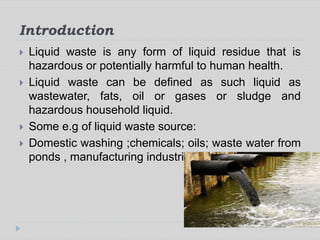Not known Facts About Reclaim Waste
Not known Facts About Reclaim Waste
Blog Article
The 9-Minute Rule for Reclaim Waste
Table of ContentsA Biased View of Reclaim WasteUnknown Facts About Reclaim WasteThe Best Guide To Reclaim Waste10 Easy Facts About Reclaim Waste ExplainedReclaim Waste - An Overview
Check out the kinds, occurrences, and types of fluid waste. Domestic sewage waste describes the waste and products from a household septic storage tank. This sort of waste is developed by human beings in houses, institutions, and various other structures. This only consists of sewage-disposal tanks that have a drain area. The proper monitoring and disposal of domestic sewer waste require fluid waste to be transferred to a sewer treatment plant where the appropriate methods and tools are related to cleanse and take care of waste.
Commercial waste commonly includes prospective threats, such as flammable products or a combination of liquid and solid waste items, and calls for a more innovative and detailed disposal process. The disposal of business waste typically includes the purification of waste before transport to ensure risk-free and correct disposal. Hazardous waste is created from by-products and overflow of commercial procedures and production.
This kind of waste can not utilize the very same sewer monitoring transportation or processes as septic or industrial fluids. The hazardous waste monitoring procedure calls for the examination and screening of liquid waste before it undergoes the disposal process (industrial wastewater treatment). Runoff waste is the liquid waste that originates from overflow and excess stormwater in very inhabited locations or cities
Overflow waste can cause contamination and flooding otherwise handled effectively. Discover more regarding drain cleaning and waste management. Guaranteeing appropriate waste management can avoid disasters and reduce ecological injury. Both people in property settings and professionals in commercial or manufacturing sectors can profit from understanding the processes and laws of fluid waste administration.
Some Known Factual Statements About Reclaim Waste
Get in touch with PROS Providers today to find out about our waste administration and disposal solutions and the appropriate means to take care of the fluid waste you produce.
(https://pubhtml5.com/homepage/kwjac/)Do you recognize what occurs to your water when you disengage, purge the bathroom or drain the cleaning device? No? Well, it deserves recognizing. This so-called 'wastewater' is not just a vital source but, after therapy, will be released to our land, waterways or the sea. Utilized water from toilets, showers, baths, cooking area sinks, laundries and commercial processes is called wastewater.

water made use of to cool equipment or tidy plant and tools). Stormwater, a form of wastewater, is runoff that moves from farming and metropolitan areas such as roof coverings, parks, gardens, roadways, paths and seamless gutters into stormwater drains pipes, after rain. Stormwater moves without treatment directly to local creeks or rivers, ultimately reaching the ocean.
The Buzz on Reclaim Waste
In Queensland, many wastewater is dealt with at sewer therapy plants. Wastewater is carried from residential or commercial websites via a system of sewage systems and pump terminals, known as sewerage reticulation, to a sewage treatment plant. City governments develop, preserve and run most sewage treatment plants. Operators are certified under the Environmental Defense Act 1994 to release cured wastewater at an appropriate ecological criterion right into rivers.
The Department of Natural Resources encourages city governments regarding managing, operating and maintaining sewage systems and therapy plants. In unsewered locations, regional federal governments may require owners to mount private or family sewage treatment systems to deal with residential wastewater from bathrooms, cooking areas, bathrooms and washings. The Division of Natural Resources authorises making use of house systems when they are confirmed to be efficient.
Many stormwater receives no therapy. In some brand-new neighborhoods, treatment of some stormwater to get rid of trash, sand and gravel has actually begun using gross toxin traps. Wastewater treatment takes place in four phases: Eliminates strong matter. Larger solids, such as plastics and various other objects mistakenly released to sewers, are gotten rid of when wastewater is passed with screens.
Utilizes little living organisms understands as micro-organisms to damage down and remove staying dissolved wastes and fine bits. Micro-organisms and wastes are included in the sludge.
Not known Details About Reclaim Waste
Nutrient removal is not available at all sewer therapy plants due to the fact that it calls for pricey specialized devices. Clear fluid effluent created after treatment may still contain disease-causing micro-organisms - liquid waste disposal melbourne.

A lot of wastewater streams right into the sewerage system. Under the Act, neighborhood governments carry out authorizations and licences for ecologically pertinent tasks (ERAs) including wastewater releases that could have a local influence.
A Biased View of Reclaim Waste
Otherwise, samples are considered laboratory evaluation. Typically several tests are needed to develop the levels of each of the different contaminants such as oils, hefty metals and pesticides in water. Monitoring article source gives factual information regarding water top quality and can confirm that licence conditions are being fulfilled. The info acquired via surveillance offers the basis for making water top quality choices.
Report this page